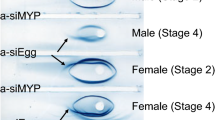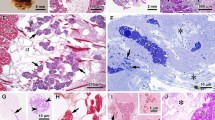Summary
Fibronectin, with a subunit molecular weight of 220,000 daltons, was isolated from the ovary of the sea urchin,Pseudocentrotus depressus, using affinity chromatography on heat-denatured mammalian collagen coupled to Sepharose 4B. The distribution of fibronectin in the sea urchin ovary was examined by indirect immunofluorescence using antifibronectin serum. The basement membrane and the connective tissues exhibited strong fluorescence. The fibronectin was localized closely together with collagen bundles in the sea urchin ovary. Biochemical and immunological examinations indicate that sea urchin fibronectin has similar properties as those of mammalian fibronectin.
Similar content being viewed by others
References
Anderson E (1968) Oocyte differentiation in the sea urchin,Arbacia punctulata, with particular reference to the origin of cortical granules and their participation in the cortical reaction. J Cell Biol 37:514–539
Baum J, McDonald A, Crystal RG (1977) Metabolic fate of the major cell surface protein of normal human fibroblasts. Biochem Biophys Res Commun 79:8–15
Cris-Benson N, Benson SC (1979) Ultrastructure of collagen in sea urchin embryos. Roux's Archives Develop Biol 186:65–70
Engvall E, Ruoslahti E (1977) Binding of soluble form of fibroblast surface protein, fibronectin, to collagen. Intern J Cancer 20:1–5
Engvall E, Ruoslahti E, Miller EJ (1978) Affinity of fibronectin to collagens of different genetic types and to fibrinogen. J Exp Med 147:1584–1595
Kleiman HK, McGoodwin EB (1976) Localization of the cell attachment region in type I and II collagens. Biochem Biophys Res Comun 72:426–432
Kleinman HK, McGoodwin EB, Martin GR, Klebe RJ, Fietzek PP, Woolley DE (1978) Localization of the binding site for attachment in the α1(I) chain of collagen. J Biol Chem 253:5642–5646
Linder E, Vaheri A, Rouslahti E, Wariovaara J (1975) Distribution of fibroblast surface antigen in the developing chick embryo. J Exp Med 142:41–49
March SC, Parikh I, Cuatrecasas P (1974) A simplified method for cyanogen bromide activation of agarose for affinity chromatography. Anal Biochem 60:149–152
Piez KA (1976) Primary structure. In: Ramachandran GN, Reddi AH (eds) Biochemistry of collagen. Plenum Press, New York, pp 1–44
Pucci-Minafra I, Galante R, Minafra S (1978) Identification of collagen in the aristotle's lanternae ofParacentrotus lividus. J Submicr Cytol 10:53–63
Ruoslahti E, Vaheri A, Kuusela P, Linder E (1973) Fibroblast surface antigen: A new serum protein. Biochim Biophys Acta 322:352–358
Ruoslahti E, Vaheri A (1974) Novel human serum protein from fibroblast plasma membrane. Nature 248:789–791
Stenman S, Vaheri A (1978) Distribution of a major connective tissue protein, fibronectin, in normal human tissues. J Exp Med 147:1054–1064
Travis DF, François CJ, Bonar LC, Glimcher MJ (1967) Comparative studies of the organic matrices of invertebrate mineralized tissues. J Ultrast Res 18:519–550
Vaheri A, Mosher DF (1978) High molecular weight, cell surface-associated glycoprotein (fibronectin) lost in malignant transformation. Biochim Biophys Acta 516:1–25
Vaheri A, Ruoslahti E, Westermark B, Ponten J (1976) A common cell-type specific surface antigen in cultured human glial cells and fibroblasts; loss in malignant cells. J Exp Med 143:64–72
Vuento M, Vaheri A (1978) Dissociation of fibronectin from gelatin-agarose by amino compounds. Biochem J 175:333–336
Vuento M, Vaheri A (1979) Purification of fibronectin from human plasma by affinity chromatography under non-denaturing conditions. Biochem J 183:331–337
Wartiovaara J, Stenman S, Vaheri A (1976) Changes in expression of fibroblast surface antigen (SFA) during cytodifferentiation and heterokaryon formation. Differentiation 5:85–89
Weber K, Osborn M (1969) The reliability of molecular weight determinations by dodecyl sulfate-polyacrylamide gel electrophoresis. J Biol Chem 244:4406–4412
Wilson LP (1940) Histology of the gonad wall ofArbacia punctulata. J Morph 66:463–479
Yamada KM, Olden K (1978) Fibronectins-adhesive glycoproteins of cell surface and blood. Nature 275:179–184
Yamada KM, Yamada SS, Pastan I (1975) The major cell surface glycoprotein of chick embryo fibroblasts is an agglutinin. Proc Natl Acad Sci USA 72:3158–3162
Zacharius RM, Zell TE, Morrison JH, Woodlock JJ (1969) Glycoprotein staining following electrophoresis on acrylamide gels. Anal Biochem 30:148–152
Author information
Authors and Affiliations
Rights and permissions
About this article
Cite this article
Iwata, M., Nakano, E. Fibronectin from the ovary of the sea urchin,Pseudocentrotus depressus . Wilhelm Roux' Archiv 190, 83–86 (1981). https://doi.org/10.1007/BF00848399
Received:
Accepted:
Issue Date:
DOI: https://doi.org/10.1007/BF00848399




